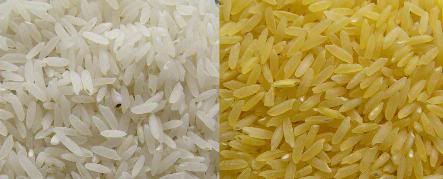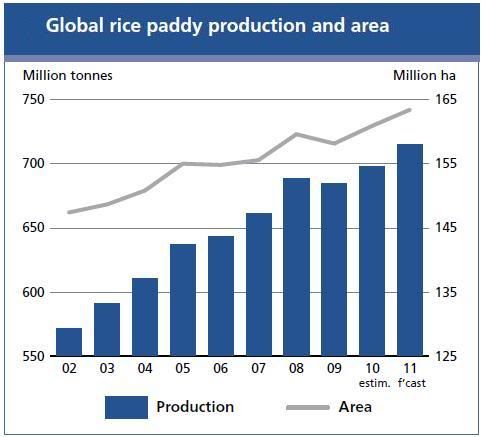
Golden rice, on the right, was engineered in 1999 to contain β-carotene. It is capable of preventing blindness and immune deficiency in children vulnerable to Vitamin A deficiency.
Rice is the food staple for half of the world's population. More than 90% of the world’s rice is grown and consumed in Asia by 60% of the world's population, on about 11% of the world’s cultivated land. Due to rapid advances in rice production, today's cost of rice is less than it was in 1960s.
Between 1966 and 2000, the population of densely-populated low income countries grew by 90% but rice production increased by 130% from 257 million tons in 1966 to 600 million tons in 2000. This was possible because of the development of high-yielding and disease and insect resistant varieties of rice, irrigation, and inorganic fertilizers. In this past decade, golden rice and flood-tolerant rice have been added to the list of advances in rice varieties.
Rice production was one of the most positive agricultural food security stories of last year. It set a new record, up 1.8 percent from 2009. Considering the El Niño and La Niña weather anomalies, which were associated with a series of droughts and floods around the world, this was remarkable. The season’s 13 million tonne increase in world paddy production can be attributed to gains in India, Asia, Bangladesh, Indonesia, Philippines, Viet Nam, Guinea, Mali, Nigeria, Sierra Leone, United States, Australia, and the Russian Federation.
Further gains are expected in 2011. The FAO projects output to increase 2.6 percent this year to 714 million tonnes, with southern hemisphere crops already looking excellent.
Japan’s rice production is down 3 percent to 10.3 million tonnes in the aftermath of their tsunami disasters.

Rice was not spared from global food inflation, however, with current export quotes exceeding their May 2010 level by 22 percent.
Global rice utilization is forecast to increase by 2 percent in 2011.

Global rice inventories at the close of crop seasons ending in 2011 could reach 137 million tonnes, implying an increase of more than 4 million tonnes, or 3 percent, from 2010. If confirmed, this would be the eighth year of consecutive increases of world rice reserves and would raise the global stock-to-use ratio to 30 percent.
K. McDonald